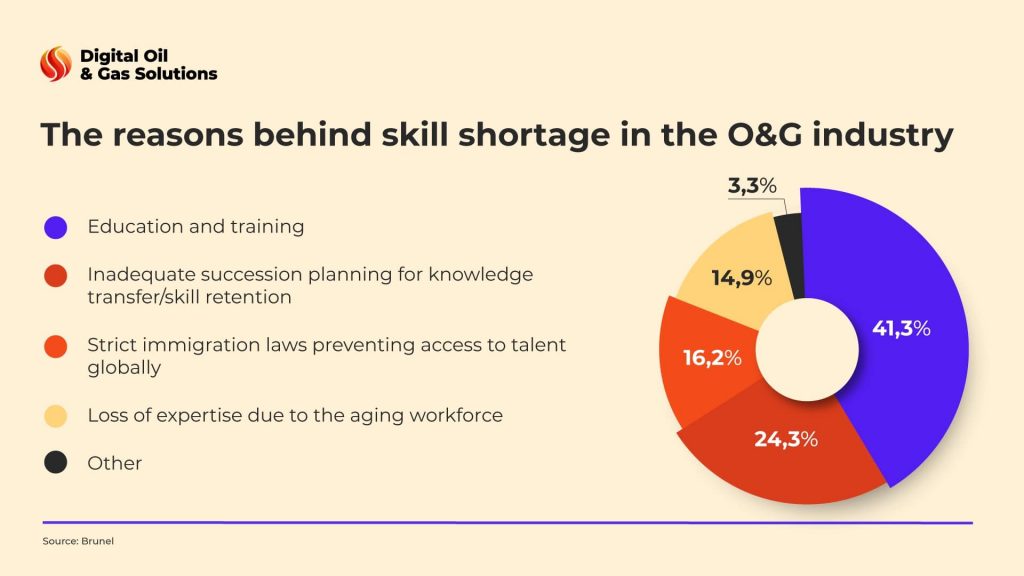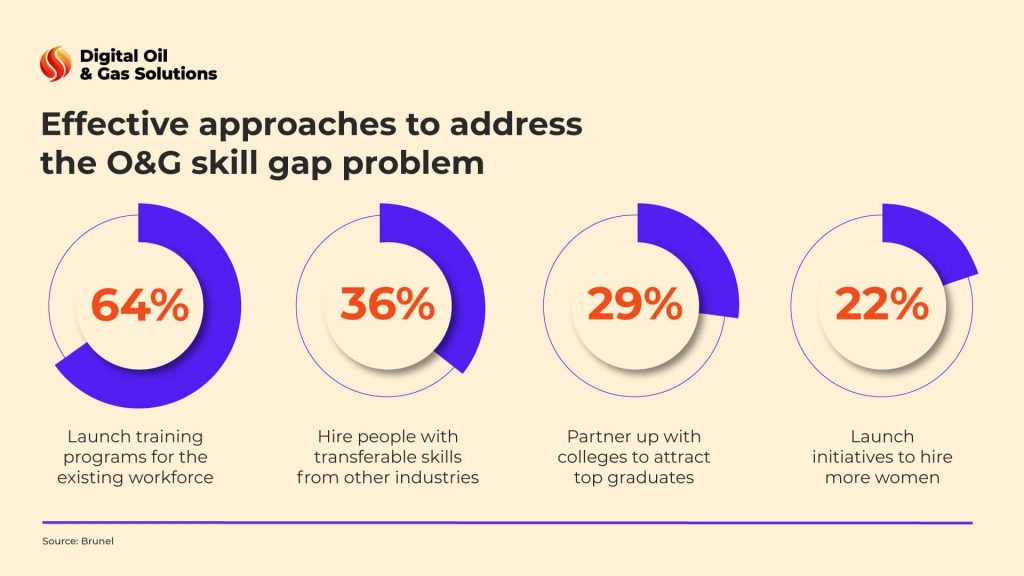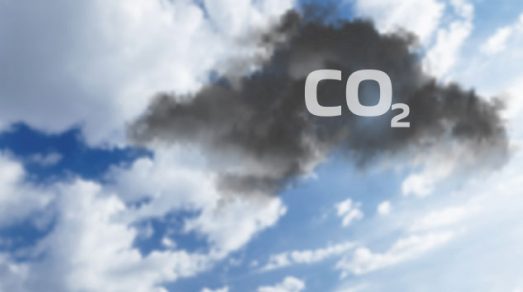Digital transformation is an integral part of the 2021 business landscape. However, too often, the oilfield workforce is not ready to embrace all the challenges brought by modern innovations. Therefore, the skill gap is growing, putting business prosperity under threat.
The reasons behind skill gaps in the oil and gas industry
As this oil and gas skills gap report shows, the dynamic is driven by several factors that are not necessarily connected. It appears that natural factors such as workforce aging are overlapped with management problems that lead to inadequate training requirements. Meanwhile, access to qualified professionals is restricted due to the current pandemic and political environment.

Here, we will divide the skills gap oil & gas factors into three main categories.
A too rapid pace of digitalization
As companies rushed into innovative technologies to stay afloat amid the crisis, it was just too much for employees to process, widening the oil and gas skills gap. Especially so, since this technological upgrade was not always complemented by consistent training. Consequently, people who have been in the industry for years suddenly realized that they don’t meet the current professional standards that have changed almost literally overnight.
Those who managed to quickly adapt and acquire new skills did it spontaneously, often on the spot, and driven by their personal sense of responsibility. However, as management didn’t create any straightforward description of a new set of in-demand skills, such professionals never gained a true understanding of what people in their roles were expected to do in the changing working environment. Therefore, today they can neither leverage nor transfer their knowledge simply because they are not aware of its volumes.
Lack of consistent training also leads to an extremely high level of uncertainty within the oil and gas workforce. This means it becomes harder to retain specialists who have picked up new skills, as they tend to migrate to companies or industries where these skills are clearly in demand. Moreover, 74.6% of oil and gas employees prioritize job opportunities that include educational and development programs.
Aging workforce
Today, the oil and gas industry is going through a generational shift called “The Great Crew Change.” Baby Boomers who used to dominate the industry are now on the threshold of retirement, and they can’t pass their experience to the new generation because new hirings are not as large as the wave of retirements. So, aging employees have no one to share their years of experience with. This creates a massive skill gap.
But what about those experienced employees who are not planning to retire yet? The problem is that they are not always tech-savvy enough to master new skills. This leaves executives with one viable option — hiring millennials or Gen Z representatives. But that’s not as easy as it may sound.
Lack of new talent
It has already become commonplace that younger workers have different career priorities. They are concerned about their environmental conditions, seek work-life balance, and look for innovations in their everyday tasks. All of these make it hard for the oil and gas industry to attract and retain them.
The situation with travel and immigration restrictions makes it even worse, as it narrows down the selection pool. You may say that in 2021 it shouldn’t be a problem, as remote monitoring is available through edge computing, and employees can perform their tasks from any corner of the world. However, sometimes this contradicts the compliance rules, so strict immigration laws remain a problem for hiring specialists in house.
Strategies and tactics to address the skill gaps problem
Companies check various approaches trying to mitigate the skills gap. Oil and gas 2021 landscape is ever-changing, so it’s not clear yet what strategies will dominate. Therefore, it’s wise to choose the one that meets your business needs or combine several tactics to achieve the best results. However, identifying skills gaps is the one step you cannot skip, so we will start our guideline with it.
Identifying skills gaps
We suggest taking a short test to identify skills gaps. It consists of several steps:
- Examine your business strategy and write down the key goals it entails
- Note what professionals are required to reach these goals
- Describe what skill set each of these professionals needs to perform their tasks
- Make a list of the skills your existing professionals have
- Compare these two lists and calculate your skill gap
After this, you can proceed with choosing the most suitable tactics for closing this skill gap.

Train existing employees
This option seems the most obvious; however, it has its pitfalls. As the research shows, 43% of workers can and will be reskilled, which sounds promising, but there are still 17% who can’t be upskilled. Therefore, training closes just half of the skill gap.
You can either organize an in-house training schedule or hire training experts to design a unique program for your company. In each case, make sure that the program covers both theoretical and practical aspects (including instructor-led sessions and demonstrations as well as tasks and exercises).
Create new job opportunities
Inviting young specialists is about building a solid professional foundation for the industry’s future. As we’ve mentioned, Millennials and Gen Z representatives are interested in new technologies and have high expectations for working culture. This means that companies will have to rethink their policies regarding inclusivity, environmental responsibility, and career growth opportunities to create workplaces that will look attractive to younger specialists.
Overcoming gender imbalance is another way to engage a new workforce. Female employees can help close skills gaps as effectively as male ones, bringing new talent to the industry. This is a “kill two birds with one stone” solution, as it also contributes to creating an inclusive environment that meets the requirements of modern society.
Automate processes that require tech-savviness
Some companies prefer not to puzzle over employee training or new talent engagement. Instead, they choose to replace humans with machines and automate their tasks. Such an approach has undeniable benefits, as automation has the potential to reduce accidents and injuries by 6% while bringing $220 billion additional value to the industry. Machines are better and faster than people at data analytics, so RPA unlocks new opportunities for data-driven decisions, predictive modeling, and business scaling. With automation, you can manage resources using next-gen ERP that relies on the data provided by smart devices.
On the other hand, machines lack creativity and flexibility, so they can’t replace humans when it comes to more complex data science tasks that require consideration of different levels.
Outsource projects and tasks
Partnering up with external companies to augment your staff with new talent can help solve short-term tasks. The main pitfall is that you’ll need to invest time and money in a new team onboarding. On the bright side, external oil and gas professionals are pre-trained to quickly capture your tasks, close the skill gap, and contribute to the overall business strategy. 30% of today’s businesses rely on this solution to close skills gaps, while 38% are planning to do so. They can count on the expertise of such teams in their selected field, e.g., IT infrastructure design, custom software engineering, or development of a cyber resilience ecosystem within a company.
Attract professionals from other industries
Hiring dedicated professionals from other industries is also an option to close the skill gap. As the industry is evolving towards cloud computing solutions, AI, digital twins, and IoT, you can invite professionals who have hands-on experience with these technologies in different fields. Of course, you will have to give them some time to dive into all the industry nuances, but altogether, such professionals are already prepared to perform tasks they specialize in.
Closing thoughts
As the oil and gas companies started identifying skills gaps that prevent them from growing, it becomes time to choose what tactics will work best for them. This implies testing various approaches and finding a perfect balance between upskilling existing employees and engaging new talents. This process requires large financial investments, so if you need to make sure your effort won’t go in vain, it’s wise to take advice from experienced professionals who will help you close your skill gap before it jeopardizes your ROI.






